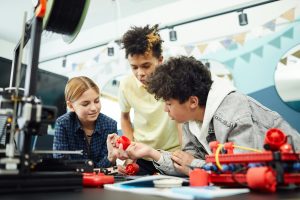Generative AI in Classrooms: Automating Lesson Plans and Feedback
The traditional classroom model for education has been the same for centuries – a teacher lecture followed by a standard textbook-based lesson and an assessment to measure understanding. However, with the rise of technology, there is a growing demand for a more personalized and adaptive approach to learning. This is where generative AI comes into the picture – a revolutionary tool that automates lesson plans and provides real-time feedback for students. In this article, we will explore the potential of generative AI in classrooms, its benefits, and future implications for education.
The Power of Generative AI in Classrooms
Generative AI, also known as Generative Adversarial Networks (GANs), are deep learning algorithms that can create new data by analyzing and learning from existing data. This technology is not limited to just producing images or videos; it can extend to generating educational content as well. GANs have fueled the development of smart education tools that can automate tasks previously done by teachers, such as creating lesson plans and providing feedback to students.
Automating Lesson Plans
The traditional method of creating lesson plans is often time-consuming, tedious, and repetitive for teachers. With generative AI, the process can be simplified and optimized. By analyzing large sets of educational data and materials, GANs can create personalized lesson plans tailored to the learning needs and abilities of each student. This not only saves time for teachers, but it also enables a more efficient distribution of resources within the classroom.
Moreover, generative AI can also generate diverse and creative lesson plans, reducing the chances of students getting bored with the same content. This approach can lead to more engaging and effective learning experiences, as students are more likely to retain information when it is presented in various ways.
Providing Real-time Feedback
One of the biggest challenges for educators is providing personalized feedback to a large number of students within a limited amount of time. With generative AI, feedback can be provided in real-time, allowing students to immediately apply corrections and improve their understanding of the material. This is possible through AI-powered chatbots and virtual assistants that can interact with students and provide customized feedback based on their performance.
Furthermore, generative AI can also identify patterns in student performance and provide insights to teachers. This data can help teachers understand the strengths and weaknesses of each student, enabling them to develop individualized learning plans.
Benefits of Generative AI in Classrooms
Personalized Learning
Generative AI has the potential to revolutionize the traditional one-size-fits-all approach to education. By creating personalized lesson plans and providing tailored feedback, students can learn at their own pace and in a way that best suits their learning styles. This can result in a more engaging and effective learning experience, leading to better outcomes for students.
Efficiency and Time-saving
By automating tasks such as creating lesson plans and providing feedback, generative AI can save teachers a significant amount of time. This time can then be utilized for more meaningful interactions with students or for developing new teaching strategies. It also allows teachers to focus on areas where they have the most impact, such as providing guidance and support to students.
Equal Opportunities for Learning
The use of generative AI in classrooms can also bridge the gap between students with different abilities and learning backgrounds. By providing personalized learning, students who may have struggled with traditional teaching methods can now have equal opportunities to succeed. It can also cater to students with special needs, providing them with a more inclusive learning experience.
The Future of Generative AI in Education
The potential for generative AI in classrooms is immense, and the possibilities are endless. As technology continues to advance, we can expect to see more sophisticated applications of generative AI in education. Here are some future implications:
Adaptive Learning Platforms
With the constant feedback and data collected by generative AI, we can expect to see more adaptive learning platforms that can personalize lessons and assessments even further. These platforms can customize the content, format, and pacing of learning material, making it more engaging and effective for individual students.
Virtual Teachers
With the advancements in natural language processing and virtual reality, we may see the emergence of “virtual teachers” powered by generative AI. These virtual teachers can interact with students in a human-like manner, catering to their learning needs, and providing continuous feedback and support.
Continuous Learning
Generative AI can also enable continuous learning, where students are provided with personalized learning material beyond the classroom. This can be in the form of online courses, interactive quizzes, or personalized recommendations for additional learning resources based on individual performance.
In conclusion, generative AI is paving the way for a more personalized and efficient approach to learning. It has the power to transform the traditional classroom model and provide equal opportunities for all students. As we continue to embrace technology in education, we can expect to see more revolutionary applications of generative AI in the future.









